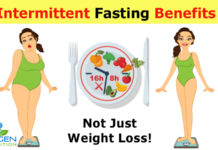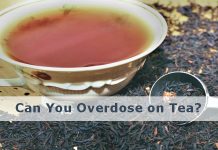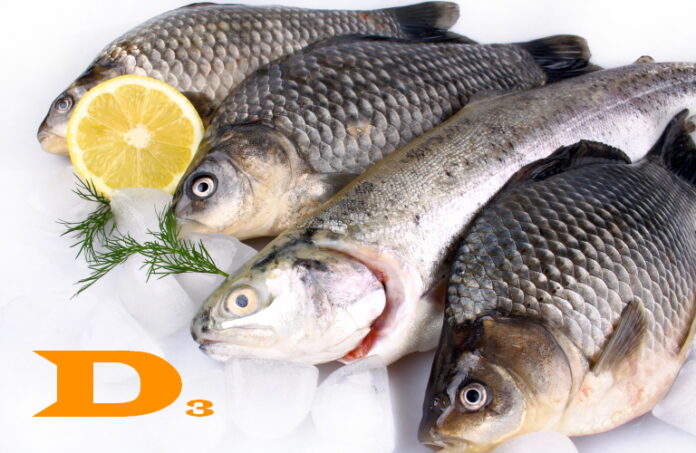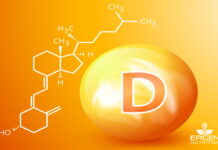Vitamin D also known as calciferol is a fat soluble vitamin that can help the body absorb and retain calcium and phosphorus which are both critical for building our bones.
But over the years scientists have discovered that a large number of our body’s organs and tissues have receptors for vitamin D.
This means there many more important functions for this nutrient, which are way beyond being just beneficial for bone health alone.
How Much Vitamin D Should We Take?
Generally vitamin D is measured in International Units (IU), and the daily recommended intake is 400 – 600 IU for adults up to the age of 70, and about 800 IU if you are 70 years old or above.
There may be some instances where a situation arises which may require you to take more, for example if you have a deficiency where there is a need for higher doses of vitamin D.
But the maximum upper limit is 4000 IU, and you shouldn’t be taking this much or more without the approval of your doctor or medical practitioner.
How Do We Get Vitamin D?
There are 3 common ways we can get our daily amount of vitamin D, the first and natural way is from exposure to sunlight, where our body then goes through a process of converting that sunlight into vitamin D3.
The next is from eating foods that contain vitamin D; this can be in the form of D2 (from plant sources) or D3 (from animal sources).
And the 3rd is by way of taking a vitamin D supplement.
There are not many foods available which are naturally rich in vitamin D, with the finest sources coming from the flesh of fatty fish and oils from fish livers.
Here are 7 of the top sources of vitamin D that are generally available for you to purchase from most big food stores.
Cod Liver Oil:
It’s not everyone’s typical idea of a food source, but just one small teaspoon of this stuff packs in a whopping 453 IU of vitamin D.
Not only that, it also contains high levels of vitamin A, along with the omega-3 fatty acids EPA and DHA.
Mackerel:
There are over 30 different species of fish which are commonly referred to as mackerel, but whatever one you decide on, you are going to get a decent amount of vitamin D.
Mackerel gives us 640 IU of vitamin D per 3 ½ oz (100g) serving.
On top of that are added bonus nutrients such as protein, omega-3 fatty acids EPA and DHA, vitamin A, phosphorus, potassium, vitamins B-6 and B12, cobalamin, magnesium and selenium.
In short, this little powerhouse is one of the healthiest seafood options that are available.
Rainbow Trout:
This lovely colourful fish is a relative of the salmon family, it happens to be the most common of the trout species, and is among the healthiest fish you can put on your plate.
Rainbow Trout gives us 635 IU of vitamin D per 3 ½ oz (100g) serving.
It also contains vitamins A, E, 6 of the B vitamins and Folate, it is high in protein, rich in omegas 3 & 6, plus has 10 different minerals.
Salmon:
Fresh salmon is an excellent source of vitamin D, and is readily available to buy in most large food stores.
Fresh salmon supplies us with 526 IU of vitamin D per 3 ½ oz (100g) serving.
It also has impressive health benefits, being high in omega 3s, protein, vitamin A, multiple B vitamins, and several beneficial minerals.
Canned Tuna:
Canned tuna is a popular, inexpensive, convenient source of protein, omega-3 fatty acids and good alternative to fresh tuna.
Because they can last for a long time, they are great for storing in your pantry then bringing out for easy lunches or quick snacks.
Canned tuna packs in 280 IU of vitamin D per 3 ½ oz (100g) serving.
There are many varieties of tuna, and as there are concerns that some species of tuna contain higher levels of mercury than others, you should just enjoy a can now and again and not make it part of your everyday diet.
Herring:
The herring is a versatile fish which is a healthy and convenient way to get your vitamin D, because of the various ways you can eat it.
It can be eaten fresh, pickled, out of a can as a snack, or even smoked as a kipper.
Herring provides us with 214 IU of vitamin D per 3 ½ oz (100g) serving.
But vitamin D isn’t the only reason to eat herring; it also delivers numerous other benefits by being rich in protein, vitamins and minerals, plus contains a healthy supply of omega 3 and 6 fatty acids.
Canned Sardines:
Sardines may not be one of the best tasting fish in the world, but that doesn’t mean it shouldn’t be a regular addition to your weekly diet.
It has lots of health benefits attributed to it, due to its high content of vitamins, minerals (including calcium), omega-3 fatty acids and protein.
Canned sardines give us 192 IU of vitamin D per 3 ½ oz (100g) serving.
If maybe you have been avoiding eating fish because of the concern about mercury, you can eat sardines without worry, because they live on plankton so their mercury content is quite low.
So if you are looking for an inexpensive, healthy convenient food, canned sardines must be near the top of the list.



































